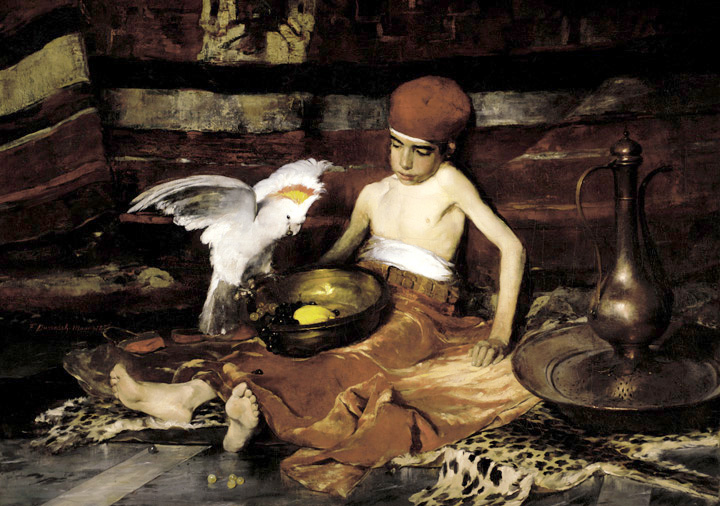
The Turkish Page
Frank Duveneck
The son of German immigrants, Frank Duveneck received his earliest art training from an apprenticeship with a church decorator in Cincinnati, across the river from his birthplace, Covington, Kentucky. Desiring further study, he went to Munich in 1869, at the time second only to Paris as a center of art instruction. Duveneck became a leading exponent of the so-called Munich School, which emphasized unsentimental realism, a dark palette, rapid brushwork, and rich impasto, all derived from old masters such as Rembrandt, Hals, and Velázquez, and modern realists like Courbet and Manet. Duveneck's prime contribution to American art is the adaptation of this bold, painterly, anti-academic style into a truly American form.
Duveneck painted "The Turkish Page" in the Munich studio of his colleague William Merritt Chase, who based a painting on this scene as well. Although Duveneck's painting was recognized as his most ambitious - and a technical triumph - when it was exhibited in 1877 at New York's National Academy of Design, the work's lack of narrative focus in favor of a still life treatment, and the unidealized depiction of the emaciated child, perplexed viewers. However, by the time of its display at the Pennsylvania Academy's 1893-94 annual exhibition (from which it was purchased), greater acceptance of cosmopolitan styles and subject matter had secured Duveneck's critical reputation as an American old master.
Artist
Date of Birth
(1848-1919)
Date
1876
Medium
Oil on canvas
Dimensions
42 x 58 1/4 in. (106.68 x 147.955 cm.)
Accession #
1894.1
Credit Line
Joseph E. Temple Fund
Copyright
No known copyright restrictions
Category
Subject
More by
We're so excited you're planning to visit PAFA!
Make time for art — visit us Thursday to Sunday.
Before reserving your tickets, please review helpful information about museum hours, accessibility, building access, and special admission programs.
If you have any questions, feel free to reach out to us at visitorservices@pafa.org — we’d love to help!